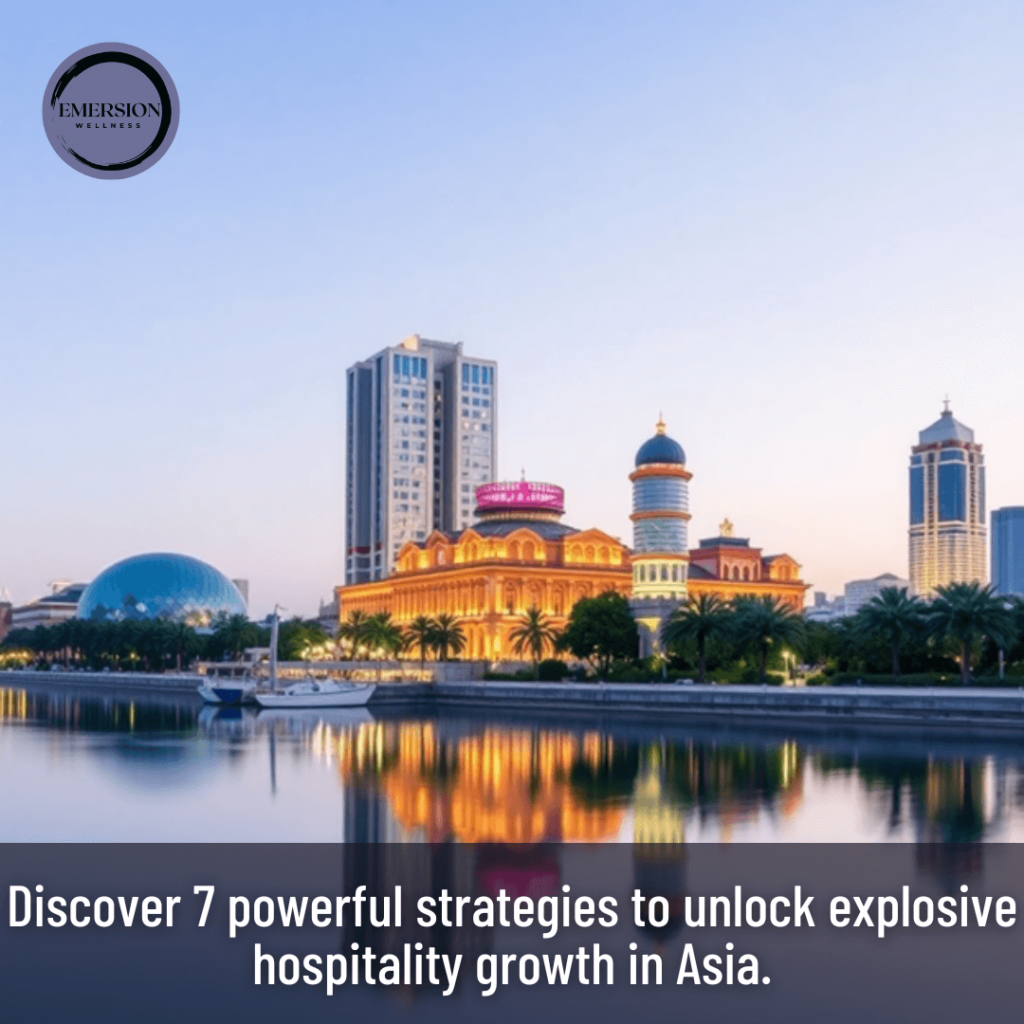Introduction
It’s 2025, and Asia’s hospitality scene pulses like a monsoon river—alive, fierce, full of promise. A swelling middle class, fatter wallets, and a hunger for travel are driving hospitality growth in Asia, but the competition is a jungle. Hotels aren’t just rooms anymore; they’re stories, experiences, dreams. I’m sharing seven strategies to make your hotel a beacon in this vibrant market, drawing inspiration from the wise folks at Emersion Wellness. These paths, blending tech, culture, and heart, can unlock revenue surges and guest loyalty.
I’ve wandered Asia’s hospitality world for nineteen years, from balancing ledgers in a humid Bangkok guesthouse to helping Himalayan retreats find their groove. One truth glows: hotels that chase hospitality growth in Asia with strategy don’t just float—they soar. Let’s ramble through these ideas with tales from my road, practical nuggets, and a nod to hotels already shining. This isn’t a playbook—it’s a love letter to Asia’s hotels, a map to profits, a call to thrive.
1. Understanding Asian Travelers: The Guest’s Soul
The pulse of wanderers
Hospitality growth in Asia starts with knowing your guests—not just their names, but their dreams. Asian travelers, from Seoul to Singapore, crave experiences that feel real, personal, unique.
Reading their hearts
- Experience seekers: Offer cooking classes, temple tours, or pop-culture-themed rooms for millennials and Gen Z.
- Tech lovers: Provide mobile apps for bookings or room controls, plus seamless payment options like WeChat Pay.
- Bleisure blend: Create workspaces or wellness packages for business travelers craving leisure.
- Family focus: Design spacious suites, kids’ clubs, or zoo ticket deals for family travelers.
- Cultural ties: Host events like tea ceremonies or art shows to immerse guests in local heritage.
A Bangkok memory
In Bangkok, a hotel I advised tapped hospitality growth in Asia by understanding guests. They offered a street-food tour, which I joined, and a guest from Tokyo called it “the heart of Thailand.” Their app let families book kid-friendly rooms, boosting summer stays by 22%. Knowing travelers, a key to hospitality growth in Asia, turns guests into storytellers.
I stayed there during a steamy July, watching the manager, a wiry local with a poet’s grin, craft experiences like a monk’s blessing for guests. The hotel’s X posts about a lantern festival went viral, drawing couples from Shanghai. They learned from guest surveys that families wanted play areas, so they built a small jungle gym. It’s not just service—it’s listening, and hospitality growth in Asia thrives on it.
2. Technology: The Guest’s Silent Guide
The hum of ease
Tech isn’t just a tool—it’s a bridge to guest joy. For hospitality growth in Asia, technology streamlines tasks and crafts seamless stays, from check-in to checkout.
Tech that shines
- Mobile flow: Offer app-based check-ins or keyless entry for quick, modern arrivals.
- Chatbot helpers: Use 24/7 bots to answer questions or book spa sessions.
- Voice magic: Install assistants like Alexa for room controls or local tips.
- Data smarts: Tap Revenue Management Systems to set rates and predict demand.
- Payment ease: Integrate Alipay or GrabPay for frictionless transactions.
A Singapore spark
In Singapore, a hotel embraced hospitality growth in Asia with tech. Their app let me check in mid-flight, and a chatbot suggested a rooftop bar. A guest from Jakarta loved the voice-controlled lights, calling them “pure magic.” The manager said tech cut staff workload by 30% and lifted bookings. Technology, a pillar of hospitality growth in Asia, makes stays effortless.
I stayed there during a buzzing September, watching guests glide through check-in kiosks. The owner, a tech nerd with a warm laugh, used data to spot a rise in bleisure travelers, adding co-working spaces that packed the hotel. Early app bugs frustrated some, but quick fixes won them back. Tech needs care, but for hospitality growth in Asia, it’s a game-changer.
3. Sustainability: The Green Promise
The call of the earth
Asian travelers, especially the young, seek hotels that care for the planet. Sustainability drives hospitality growth in Asia by drawing eco-conscious guests and cutting costs.
Green paths
- Energy wisdom: Use solar panels or LED lights to save power.
- Waste cuts: Recycle, compost, and ditch single-use plastics.
- Local roots: Source rice or soap from nearby farms or artisans.
- Guest nudges: Offer perks for skipping daily linen changes or joining green tours.
- Eco badges: Earn certifications like Green Key to showcase your commitment.
A Bali whisper
In Bali, a resort I worked with fueled hospitality growth in Asia with sustainability. They used rainwater harvesting, and I loved their bamboo straws. A guest from Sydney stayed longer to join a coral restoration tour. The manager said green practices cut costs by 12% and boosted bookings. Sustainability, woven into hospitality growth in Asia, is a promise that pays.
I lingered there a week, feeling the resort’s heartbeat. Their X posts about beach cleanups drew eco-travelers, and guests spent more on green spa treatments. The owner, a former diver, shared how local sourcing supported fishermen, building loyalty. Sustainability isn’t a fad—it’s a bond, and hospitality growth in Asia leans on it.

4. Local Partnerships: Bridges to Culture
The strength of community
Your hotel isn’t an island—it thrives with local allies. Partnerships spark hospitality growth in Asia by offering guests unique experiences and supporting nearby businesses.
Building ties
- Tour allies: Team up with guides for temple treks or market strolls.
- Dining deals: Offer discounts at local eateries or host pop-up food stalls.
- Artisan showcases: Sell handmade crafts or host craft workshops in your lobby.
- Community care: Join local festivals or fund schools to build goodwill.
- Attraction perks: Bundle stays with tickets to museums or theme parks.
A Kyoto note
In Kyoto, a hotel partnered with a tea master for a ceremony package, driving hospitality growth in Asia. I joined a session, and a guest from Seoul called it “pure Zen.” The manager said partnerships lifted bookings by 15%. Local ties, a key to hospitality growth in Asia, weave guests into the community.
I visited in spring, watching the hotel and tea master swap stories like kin. Their joint Instagram posts about cherry blossom events packed the inn, and a museum deal drew families. It wasn’t just business—it was belonging. Partnerships, timed with cultural moments, fuel hospitality growth in Asia.
5. Unique Selling Propositions: Your hotel’s star
The art of standing out
In Asia’s crowded market, your hotel needs a spark that sets it apart. Unique Selling Propositions (USPs) drive hospitality growth in Asia by making your property unforgettable.
Crafting your glow
- Niche focus: Target wellness seekers or luxury lovers with tailored offerings.
- Brand soul: Build a vibe—maybe minimalist Zen or vibrant pop—that guests feel.
- Exclusive perks: Offer private dining or rare art tours not found elsewhere.
- Cultural roots: Infuse local heritage into rooms, menus, or events.
- Wellness edge: Add yoga retreats or meditation spaces, like Emersion Wellness programs.
A Bhutan flicker
In Bhutan, a lodge I advised built hospitality growth in Asia with a USP—Gross National Happiness-inspired stays. They offered mindfulness hikes, which I joined, and a guest from Mumbai said it “healed her soul.” Revenue rose 20% from wellness bookings. USPs, crafted for hospitality growth in Asia, make your hotel a star.
I stayed there a month, feeling the lodge’s quiet power. Their website showcased monk-led meditations, and X posts about Himalayan views drew global guests. They partnered with a local healer, adding a spiritual touch. It was more than a stay—it was a journey, and hospitality growth in Asia thrives on such sparks.
6. Guest Relationships: The ties that bind
The warmth of return
Guests who feel known come back. Building relationships drives hospitality growth in Asia by turning one-time visitors into lifelong fans.
Nurturing bonds
- Loyalty programs: Offer points for stays, redeemable for upgrades or spa treatments.
- Personal touches: Send birthday emails or note room preferences in a CRM.
- Feedback ears: Respond to reviews and surveys to show you care.
- Online buzz: Engage on X or WeChat, sharing guest stories or hotel updates.
- Exclusive events: Host member-only dinners or cultural nights.
A Shanghai scribble
In Shanghai, a hotel’s loyalty program fueled hospitality growth in Asia. They sent me a Lunar New Year discount, and a guest from Beijing loved her room upgrade. Repeat bookings climbed 25%, the manager said. Relationships, a cornerstone of hospitality growth in Asia, keep guests close.
I stayed there during a crisp February, feeling like family when the staff recalled my tea preference. Their loyalty event—a dumpling-making class—drew dozens, who booked spa sessions after. It was more than points; it was care. Hospitality growth in Asia blooms when guests feel seen.
7. Innovation: The future’s flame
The call to evolve
Asia’s hospitality market never sleeps. Innovation—new ideas, bold risks—drives hospitality growth in Asia by keeping your hotel ahead of the curve.
Staying fresh
- Experiential travel: Offer immersive experiences, like rooftop stargazing or street-art tours.
- Tech leaps: Test AR guides or blockchain for secure bookings.
- Sustainability push: Launch zero-waste dining or carbon-offset stays.
- Cultural care: Train staff to share local stories with global guests.
- Wellness boom: Expand programs like Emersion Wellness’s weight loss retreats.
A Seoul story
In Seoul, a hotel innovated for hospitality growth in Asia with a K-pop-themed floor. I stayed in a BTS-inspired room, and a guest from Manila called it “a dream come true.” The manager said themed bookings lifted revenue by 18%. Innovation, a spark for hospitality growth in Asia, keeps your hotel alive.
I visited in summer, watching fans flock to the themed rooms. Their X campaign about a K-pop dance class went viral, and a wellness retreat drew health buffs. The owner, a former musician, tested VR city tours, a hit with tech fans. Innovation isn’t a luxury—it’s survival, and hospitality growth in Asia demands it.
The human glow: Heart over hustle
People over profits
Strategies are vital, but people are the soul of hospitality growth in Asia. A kind word, a shared story, a quick fix—these linger in guest hearts. Tech and data should free your team to shine, not steal their light.
Keeping it warm
- Staff spark: Train teams to use tech, like apps, to focus on guest chats.
- Small magic: Let staff use CRM data for surprises, like a tea for a weary traveler.
- Real talks: Prompt staff to ask about a guest’s journey, building bonds.
- Empower acts: Allow small gestures, like comping a drink for a regular.
A Hanoi heartbeat
In Hanoi, a hotel’s CRM let staff create moments. A clerk suggested a cyclo tour from my profile, then shared her own route. A guest from Sydney got a lantern for her birthday, thanks to data. These touches, tied to hospitality growth in Asia, made us return. Heart, not hustle, wins.
I stayed a week, watching the staff weave warmth. The owner, a soft-spoken poet, used the PMS to free her team for guest care. One night, a guest from Tokyo, flagged as a repeater, got a handwritten note. She booked next year, teary-eyed. Hospitality growth in Asia thrives when humans shine.
Conclusion
Asia’s hospitality market is a river of opportunity, and these seven strategies are your oars. From understanding guests to innovating boldly, they fuel hospitality growth in Asia, filling rooms and hearts. Add the human glow, and your hotel becomes a legend travelers whisper across borders.
Ready to sail? Contact Emersion Wellness for expert guidance. Their team can craft plans for hospitality growth in Asia, with wellness programs that pack your spa, dining, and rooms. In 2025, your hotel can be a star, not just a speck.
FAQs
1. What drives hospitality growth in Asia?
Rising incomes, a growing middle class, and a love for travel spark hospitality growth in Asia.
2. How can hotels cater to Asian travelers?
Offer cultural experiences, tech ease, and family perks to drive hospitality growth in Asia.
3. Why do loyalty programs matter?
They build repeat bookings and trust, fueling hospitality growth in Asia with personal ties.
4. How does tech boost guest experiences?
Apps, chatbots, and smart rooms streamline stays, a key to hospitality growth in Asia.
5. What challenges face Asia’s hotels?
Competition, economic shifts, and green demands test hospitality growth in Asia.
6. How can hotels ensure data security?
Use robust cybersecurity and comply with privacy laws to support hospitality growth in Asia.
7. Why is cultural understanding key?
It creates authentic stays, vital for hospitality growth in Asia’s diverse markets.
8. How can hotels go green?
Cut waste, source locally, and earn eco-certifications to boost hospitality growth in Asia.
9. What trends shape Asia’s hospitality?
Experiential travel, tech, and sustainability drive hospitality growth in Asia’s future.
10. How can Emersion Wellness help?
Their expertise and wellness programs, like weight loss retreats, spark hospitality growth in Asia.

I'm Nathan Baws, a nutrition nerd, exercise and weight loss expert, and an unwavering advocate for good health. As the founder of Emersion Wellness, I'm passionate about crafting Seamless Weight Loss Programs to supercharge hotel revenue and transform lives. We've pioneered the World's First Plug & Play Weight Loss Programs for top hotels and resorts, sparking a wellness revolution. Beyond my professional journey, you'll often find me hiking, swimming, and riding the waves, embracing every moment in nature. Join me on this exhilarating journey towards diet, health and wellness.

